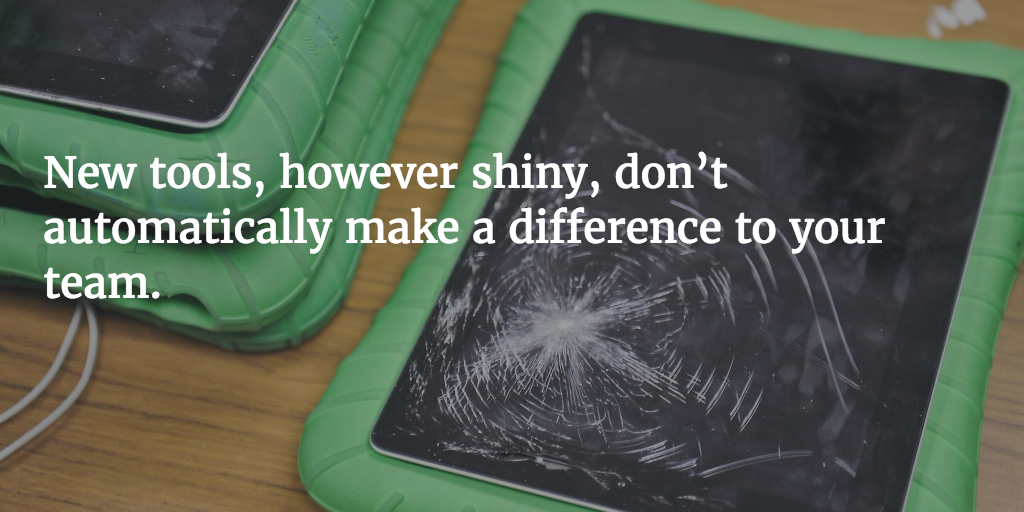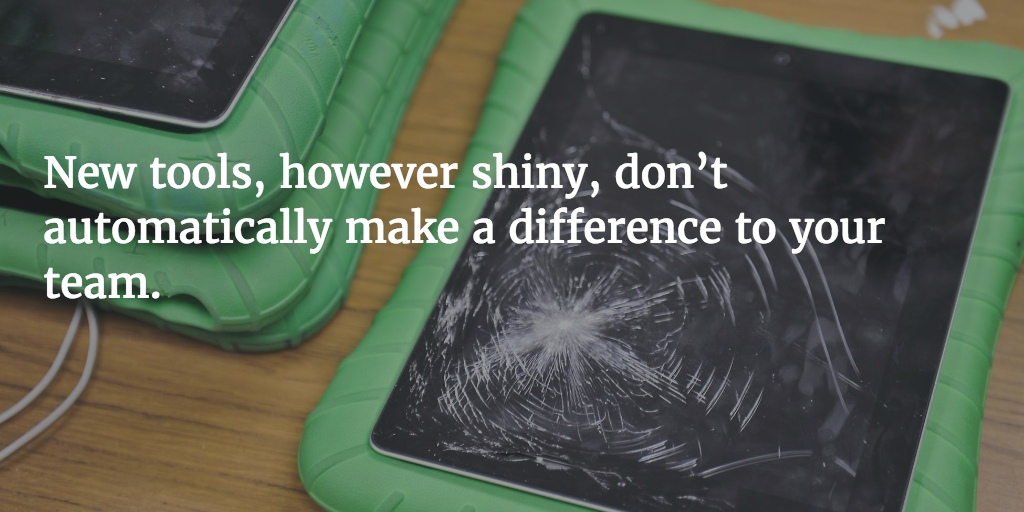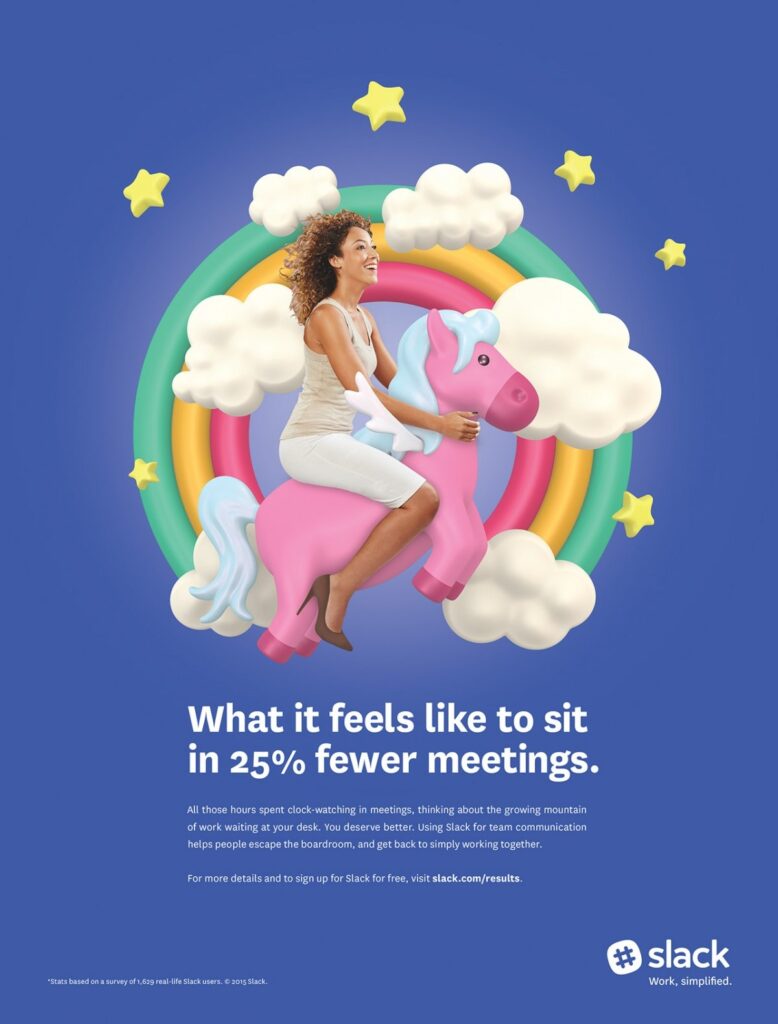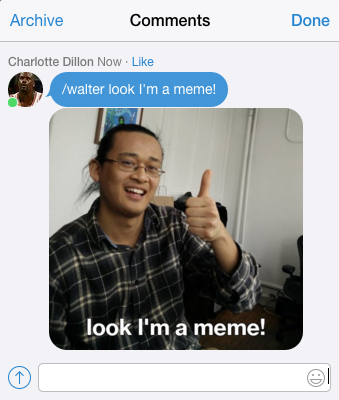In 2013, public schools in Greensboro North Carolina received a shipment of over 15,000 iPads as part of an initiative to bring technology into the classroom. Now, those very same iPads are collecting dust because teachers either refused or didn’t know how to incorporate them in their workday.
New tools, however shiny, don’t automatically make a difference to your team. It’s up to managers to get the ball rolling.
As a manager, you might be really certain that a new tool will make a huge difference. That new CRM is going to make finding information so much easier. That communication tool is going to make everyone so much more productive. And that new email provider is going to make your data so much more secure.
But new tools don’t make any difference at all if your team doesn’t get on board. It’s a really common phenomenon: you bring in new tools, but everyone is so stuck in their ways that they’re not willing to budge when it comes to changing how they do things. Even though you’re convinced it could help them.
What’s more, if there’s even one person who’s not on board, it can make the whole attempt irrelevant. How do you deal with the naysayers, as a manager?
Here’s your step-by-step guide to picking and implementing a new tool in the most low-friction way possible.
Convince Your Team by Letting Them Convince You
An international telecom company had recently consolidated a number of existing IT companies. Under the new structure, they had over 6,000 employees, were making over $4 billion in annual revenue, but had a totally baroque workflow comprised of the systems left over from the previous companies.
But when management tried to overhaul the system and incorporate a single, company-wide workflow, it blew up in their face.
The smaller companies had been doing things their way for years. Why did customer support have to start cataloging all their tickets and turning them into reports, when things were going fine? Why did the new workflow not have a review step? People simply stuck to the old ones because they weren’t convinced the new ones were better.
New tools are going to go unused—like those iPads in North Carolina—if no one is convinced that they’re necessary.
1. Ask Questions that Identify their Pain Points
In order to get people on board with change, they need to propose it themselves. That’s why before implementing a new tool—before even picking a new tool—it’s important for your team to think critically about the status quo and recognize their pain points.
In his bestselling book To Sell Is Human, Daniel Pink argues that posing a solution as a question is one of the most effective ways of getting people to accept change. Just take a look at Reagan’s successful campaign slogan: “Are you better off now than you were four years ago?”
It gets people to think critically and come to a conclusion on their own, which means they’re more likely to stick to it than if the answer were handed to them from on high.
Ask questions that show your team you understand their pain points. What’s the one tool in this company you rely on most? What could you do without? It will help you understand what to look for in a new tool for your team, and will help everyone prepare for change by giving thought to what could be different in their workflow. Get your team to see the value of a new tool before implementing it. If they’re excited about adopting something, the change won’t feel like an imposition.
This ad from Slack shows that the company understands the pain behind sitting through meetings. They want to relieve that pain by making it a magical experience. They want you to envision a totally over-the-top delightful experience. They get your pain, and they want to make it go away.
2. Realize 75% of Your Answers are Wrong
As Chris Savage, CEO of Wistia says, “It’s a mistake to focus on solutions, because 75% of solutions are wrong. A lot of time gets wasted debating solutions. Rather, figure out how to test it quickly and give people the ability to do so.” Chris has found that managers can empower their teams by allowing them to make important decisions, which allows everyone to move faster with fewer bottlenecks.
So instead if implementing bad solutions, give your team the ability to do so.
The first step in this process is to understand how your team works and why. A lot of managers don’t understand their teams’ workflow. It might seem, from your side, like Salesforce is a better CRM choice for your company because it will provide you with analytics you need from a managerial standpoint, and you’re excited about using their mobile app.
But if you don’t talk to your team, you might not know that your sales team relies heavily on your current CRM’s marketing features, like automated email responses.
You change the system, and their workflow is shot. You might get what you wanted out of the switch, but the team resents you, and they’re less productive.
You need to get in direct touch with your team before changing the way they work. Talk to middle management, or bring it up in 1:1’s. If you have a giant 6,000-person company, it might require getting a task force. This is what the telecom company wound up doing before overhauling company-wide workflow to something that made sense for everyone involved.
Run Pilots Before You Buy
New tools are an investment—and not just a financial one.
It costs your team time to learn new tools, which might mean a small dip in productivity as everyone climbs the inevitable learning curve. If you’re going to make that investment, you need to be sure it’s going to pay off. One of the best ways to do so is by running a pilot of a product before overhauling your system.
The good news for you is that freemium model and free trials are the lifeblood of a lot of SaaS startups, and can really help you in a situation exactly like this. Not only can they help you as a manager choose a tool, or play around with options, they can get people on your team to see the benefits of changing up your workflow, and convert team members into advocates.
3. Run Trials in Small Groups
Since it’s such an investment to switch everyone in an organization to a new tool, you should only try it out in small groups at first. Instead of having 50 people take time out of their day to learn a new word processing tool, only give it to five people.
If you drop a 50-page manual on everyone’s desk, it’s not the same as having them understand all the new features. By using a new tool, they’re able to explore features and see what appeals to your team’s needs.
This is the kind of feedback you should solicit from your small trial group, whether it’s via Survey Monkey or a Google poll—what features are they using? What features do they still want? It can be particularly helpful to establish a task force of people interested in a tool.
4. Get Select Team members to Endorse the Tool
If the tool works well, your small-group trials will turn team members into champions for the tool. That way, when you bring it company-wide, you’ll already have people on your side ready to argue your case. This happens in part because of the endowment effect.
The term was coined after a Cornell University gave half of a room of students coffee mugs and then asked them if they’d like to sell them, and the people without mugs if they’d like to buy. Almost no trading took place, because mug-havers and mug-have-nots valued the objects totally differently.
Students with mugs set their minimum selling prices too high, and students without mugs set their maximum offers too low. As the study concluded, it’s because we value things we own and are used to.
Understanding the endowment effect can help you realize why people are so unwilling to budge. If your team has been using Hootsuite for years but you’d like to switch to Sprout Social, the endowment effect contributes to their attachment to the older system.
But by doing a trial run of Sprout Social, your team will also start to feel ownership over the new tool, which means they’ll be more willing to use it.
Continue to Onboard New Tools
Once you’ve picked the tool you’re going to use, it’s not a matter of crossing your fingers and hoping for the best. Getting your team used to a new tool is an onboarding process in and of itself.
Since it takes time to adapt to a new workflow, it’s important to follow up on how the new tool is being used, so that it doesn’t end up collecting dust like those iPads in North Carolina public schools. The best way to do this is to keep getting your team excited about the tool’s possibilities, even once it’s in place.
5. Roll Out New Features Even After You Launch the Tool
Before developing a new version of Office, Microsoft surveyed users and asked what new features they’d like to see. As it turns out, a lot of users wound up asking for features that were already available.
The phenomenon is called “feature blindness,” and it can prevent your team from getting the most they can out of a new tool. If you’ve become accustomed to using a tool in a certain way, it’s easy to become blind to all the other things it has to offer. But on the other hand, if you try to teach everyone to use every feature at once, it can get too complicated and slip through the cracks.
If you’re adopting a new tool, you need to get everyone excited about all the features and doors it will open for them. It’s a good way to get everyone using the tool regularly, and will make sure you’re getting the most value possible.
6. Make the New Tool a Game
Adopting new tools can feel like a chore.
The best way to overcome this is to make tool adoption feel fun. For example, The CEO of Vanderbloemen Search Group “gamefied” adopting HubSpot. Team members who used HubSpot the most were rewarded—not monteraily, just with a points system— which encouraged a silly competition and made it feel like fun.
As a Harvard Business Review study concluded, “Rewarding the behavior you want to see is much more effective than penalizing the behavior you don’t want to see.” This is partly because we’re motivated by positive, not negative rewards in the workplace.
One way to make a new tool feel fun is to explore its customizable features. The document sharing app Quip, for example, has customizable features like adding memes when talking to your team. It’s not the reason people choose the tool, but it’s a bonus feature that encourages engagement.
iDoneThis co-founder Walter Chen, meme-ified for comments in Quip
It’s All Up to the Team Manager
The real issue with the iPads in North Carolina schools is that teachers weren’t implementing them well. Someone higher up in the organizational structure—an administrator, or a government official allocating funds—saw the potential that tablets had in the classroom. But without cooperation from the teachers, that’s all it was: potential.
Although some teachers had implemented them effectively into their teaching plan, there was no consistency because the management—the school higher-ups—didn’t feel as though it had anything to do with them. So the students didn’t get the full benefit of that million dollar initiative.
This wasn’t the teachers’ fault. It was their managers’. That’s because, as the Harvard Business Review puts it, “The job of a manager is to help people cross the bridge — to get them comfortable with the technology, to get them using it, and to help them understand how it makes their lives better.”
In the case of the iPad example, managers weren’t getting people on board with the new technology. They weren’t in touch with teachers—at any step of the process—to see that the new tool was needed, wanted, and being used. They didn’t help teachers cross the bridge. But if you follow these steps, you’ll get your team to “cross the bridge” and your new tool will be fully functional in no time.
P.S. If you liked this article, you should subscribe to our newsletter. We’ll email you a daily blog post with actionable and unconventional advice on how to work better.





